A perennial plant elecampane (Inula), also called yellow, is a representative of the Asteraceae family, or Asteraceae. This plant can be found in nature in Africa, Asia and Europe, while it prefers to grow in quarries, near water bodies, in meadows and ditches. Also, this culture is called wild sunflower, goldenrod, thistle, bear ear, nine-force, divosil, forest jaundice, thistle or forest adonis. According to information taken from various sources, this genus unites 100-200 species. Since ancient times, elecampane has been widely used in alternative medicine, and gradually this plant began to be cultivated. Today, among gardeners, one of the species of this genus, elecampane high (Inula helenium), is becoming more and more popular: this is the most popular species that has medicinal properties.
Content
Features elecampane
Elecampane most often represents a perennial semi-shrub or herbaceous plant, however, the genus also contains annuals and biennials. Thickened roots extend from the shortened rhizome to the sides. Straight, slightly branched shoots can be smooth or pubescent. Large heart-shaped leaf plates can be oblong or lanceolate, as well as whole-edged or unevenly serrated. Baskets-inflorescences are solitary or are part of panicle or corymbose inflorescences. Baskets consist of tubular median and marginal flowers, which can be colored in various shades of yellow. The lanceolate leaves of the wrapper are green in color. The fruit is a cylindrical ribbed achene, which is glabrous or pubescent.
Growing elecampane from seeds
Before you start planting elecampane, you need to choose the most suitable site for it, while taking into account that this heat-loving plant prefers sunny places. The substrate should be moist, nutrient-rich and breathable. Sandy loam or loamy soil is suitable for planting.It is best to sow this plant after clean steam, in this case, a rich harvest will be provided to you.
Preparing the site for sowing should be done in advance. It is necessary to dig it to the depth of a shovel bayonet, while adding compost or humus (5-6 kilograms per 1 square meter), and also a potassium-phosphorus mixture (40 to 50 grams per 1 square meter). After that, the site must be fenced. Immediately before sowing, fertilizers containing nitrogen should be scattered over the surface of the site, after which they must be sealed to a depth of 10 to 15 centimeters. Then the surface of the site must be lightly tamped.
Seeds should be sown before winter or in spring (in the second decade of May). There is no need to stratify the seeds, but to facilitate sowing, gardeners advise, combine them with sand (1: 1). For one row, which is 100 cm long, you will need about 200 seeds. If the soil is heavy, then the seeds need to be buried by only 10–20 mm, and if the soil is light, by 20–30 mm. The width between the rows should be equal to 0.6–0.7 m. The seedlings will appear only when the air warms up to 6–8 degrees. The optimum temperature for growth and development of elecampane is from 20 to 25 degrees. If weather conditions are favorable, the seedlings will appear half a month after sowing. A few days before the seedlings appear, the site should be buried across the sowing rows, while all large clods of earth, as well as threadlike weed seedlings, must be removed.
This plant can be propagated by dividing the rhizome. In the southern regions, using this method, elecampane is propagated in the spring, and even in August. Moreover, in colder regions, rhizomes are divided only in spring, during the opening of leaf plates. Remove the rhizome from the soil and divide it into several parts, while each division should have 1 or 2 vegetative buds. When planting divisions between them, a distance of 0.3 to 0.65 m should be observed, while they should be buried 50–60 mm into the soil, and their buds should also be directed upward. Before planting, each well should be spilled with lukewarm water, and then fertilizers are applied to them, which should be combined with the soil. After planting, the surface of the site must be tamped, watered well, and covered with a layer of mulch. In the first year, rooted divisions will have sprouts, while their height by the end of the summer period will reach from 0.2 to 0.4 m.
Caring for an elecampane in the garden
After the seedlings of elecampane appear on the site, you will need to thin them out. The plant must be watered, weeded in a timely manner, and it is also necessary to loosen the soil surface near the bushes. In the first season, elecampane is characterized by extremely slow growth, so, at the end of the summer period, the height of the bushes will not exceed 0.3–0.4 m. By this time, leaf rosettes and a root system will have to form in the bushes. The first flowering can be seen only in the next season in July, while its duration is about 4 weeks.
Watering and weeding
This culture is moisture-loving, and it especially needs water during bud formation and flowering. The bushes have a penetrating root system that is able to extract moisture from relatively deep soil layers. In this regard, watering elecampane is needed only during a prolonged drought.
Systematic weeding is needed for such plants only in the first year of growth. Already next season, the bushes will grow and get stronger so that no weed can interfere with them.
Top dressing
When leafy rosettes begin to form in the bushes, they will need feeding with Nitrofoskaya. Re-feeding is carried out 20-30 days after the first, when the growth of ground shoots begins. In the autumn, before the plant plunges into a dormant state, it should be fed with potassium-phosphorus fertilizer, which is applied to the soil.
Elecampane collection and storage
Elecampane rhizomes with adventitious roots may be removed in the second year of growth. After the seeds are fully ripe, the bush must be shortened to 50–100 mm, then they take a pitchfork and carefully undermine it. Remove the root from the soil, shake it off well and rinse. Then the rhizome should be cut into pieces, the length of which should be equal to 10-20 centimeters. They are laid out in a shaded place, where they will wither for 2 or 3 days. After that, the raw material should be transferred to a room with good ventilation and spread out (the layer thickness should be less than 50 mm). To dry the rhizomes, you will need to maintain the temperature in the room from 35 to 40 degrees, while the raw materials should be systematically stirred and turned over to ensure it dries evenly. For storage, elecampane is poured into dishes made of wood or glass, and you can also use bags. It retains its medicinal properties for up to 3 years.
Types and varieties of elecampane
Elecampane Royle (Inula royleana)
The height of this perennial plant is about 0.6 m. The length of the oblong leaf plates is about 0.25 m. The inflorescences reach 40-50 mm in diameter, and they include ligulate and tubular flowers of a deep yellow color. Blooming is observed in July – August. Cultivated since 1897
Elecampane root-headed (Inula rhizocephala)
This decorative type is one of the most popular in the culture. Long lanceolate leaf plates are part of the basal rosette, in the center of which is a dense compact yellow inflorescence. The superficial root system is highly ramified.
Eastern elecampane (Inula orientalis)
The homeland of this species is Asia Minor and the Caucasus. This perennial plant with straight stems reaches a height of about 0.7 m. The leaf plates have an oblong-spatulate shape. Inflorescences reach 9-10 centimeters in diameter, they include long and thin dark yellow ligulate flowers, as well as tubular flowers of yellow color. Cultivated since 1804
Sword-leaved elecampane (Inula ensifolia)
In nature, it occurs in Europe and the Caucasus, while this species prefers to grow on mountain chalk and calcareous slopes, in forests and steppes. The height of the compact bush is 0.15–0.3 m. Thin, very strong shoots branch out in the upper part. Sedentary narrow lanceolate leaf plates are about 60 mm long. Single yellow baskets have a diameter of 20–40 mm. It has been cultivated since 1793. There is a low-growing variety: the height of the bush is about 0.2 m, it blooms magnificently and for a relatively long time.
Elecampane magnificent (Inula magnifica)
It is not for nothing that this species received such a name. This perennial plant is a powerful, spreading and majestic bush, which can reach a height of 200 cm. The stem is furrowed and thick. Large basal oblong, as well as lower stem leaf plates are half a meter long, and their width is 0.25 m.The leaves tapering at the base turn into a petiole, which can reach 0.6 m in length.The upper leaf plates are sessile, while the lower ones are much more of them. Inflorescences of yellow color in diameter reach 15 centimeters. On peduncles, reaching 0.25 m in length, they are located one by one or several pieces, forming corymbose inflorescences. Blooming is observed in July – August. The faded bush loses its decorative effect and, as a rule, is cut off.
Elecampane British (Inula britannica)
In nature, this species is found in Asia and Europe, while it prefers to grow in ravines, in sedge swamps, birch forests, steppes, along roadsides, on wet saline and forest meadows, as well as in floodplain shrub thickets. This perennial plant is not very tall; its surface is covered with gray tomentose pubescence. The ribbed erect stem is slightly red at the bottom, and in the upper part it can be branched or simple.The leaf plates are lanceolate, elliptical, or linear-lanceolate (less often ovoid), they are finely toothed or entire, with spines along the edge. The front surface of the leaves is slightly pubescent or bare, and the seamy surface has a dense covering, consisting of appressed glandular or woolly hairs. Inflorescences of yellow color reach 50 mm in diameter, they can be part of loose corymbose inflorescences or be solitary.
Elecampane high (Inula helenium)
It is found naturally in Europe, the Caucasus and Siberia, while this species prefers to grow in meadows, in light deciduous and pine forests, as well as on river banks. This perennial plant is a cylindrical bush, which reaches a height of about 250 cm. The powerful rhizome has a strong aroma. The length of the lower stem and oblong-elliptical basal leaf plates is about 0.4–0.5 m, and their width is from 0.15 to 0.2 m. Beginning from the middle of the shoot, the leaf plates are sessile and have a stem-embracing base. In diameter, the yellow-golden baskets reach 80 mm, they are located in the axils of the bracts on short peduncles and are part of rare racemose inflorescences. They began to cultivate this species in ancient times.
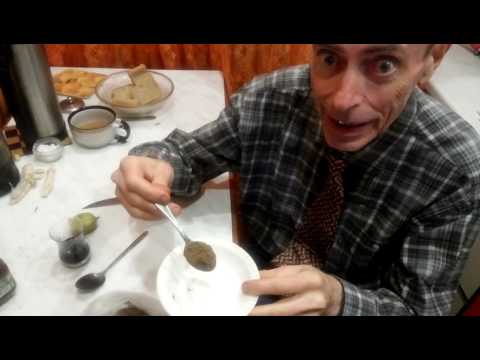

Watch this video on YouTube
Elecampane properties: harm and benefit
Healing properties of elecampane
The healing properties of elecampane are contained in its root system, which includes such substances as: wax, vitamin E, resins, essential oils, mucus, saponins, polysaccharides inulenin and inulin.
A decoction of the rhizome and roots of this plant is used in the treatment of inflammatory processes in the stomach and intestines, for example, for peptic ulcer disease, gastritis, gastroenteritis, diarrhea, as well as for diseases of the kidneys and liver, fever, acute respiratory infections, influenza, bronchitis with thick secretions, tuberculosis, tracheitis and other inflammatory diseases of the upper respiratory tract. Such a decoction is distinguished by expectorant, anti-inflammatory, diaphoretic, diuretic, antiseptic and anthelmintic. This remedy is especially detrimental to roundworm.
This broth is used for skin diseases, and if you combine it with lard, you get an excellent remedy for scabies. Fresh leaves are recommended to be applied to ulcers, tumors, scrofulous and erysipelas.
Even in alternative medicine, elecampane is used in the treatment of itchy dermatosis, purulent wounds, cystitis, venereal diseases, furunculosis, eczema, jaundice and arthritis. In the pharmacy, you can buy the drug Alanton, made on the basis of elecampane roots, it is used in the treatment of non-scarring ulcers of the stomach and duodenum. Tocopherol (vitamin E), which is part of the rhizome, is a powerful antioxidant that slows down the aging process.
To prepare an infusion of elecampane, you need to combine one small spoonful of dried roots with 250 ml of cold water. Leave the mixture for 8 hours to infuse, after which it is filtered. You need to drink 50 milligrams 4 times per knock for a third of an hour before a meal. It is used as an expectorant, and also for hemorrhoids, high blood pressure, and also as a blood-purifying agent for skin diseases.
To prepare tincture of elecampane, 120 grams of fresh rhizome of this plant is taken. It must be mixed with ½ part of a glass of port or Cahors wine. The mixture is boiled for 10 minutes, then it is filtered. Drink 2 or 3 times a day, 50 milligrams before meals. Used as a tonic and tonic for stomach ulcers, gastritis or after a serious illness.
Contraindications
Means made on the basis of elecampane should not be used for serious cardiovascular diseases, pregnancy, hypotension, gastritis with low acidity and kidney pathology.During menstruation, which is accompanied by severe pain, these drugs can intensify them. When treating children, elecampane is used with great care.

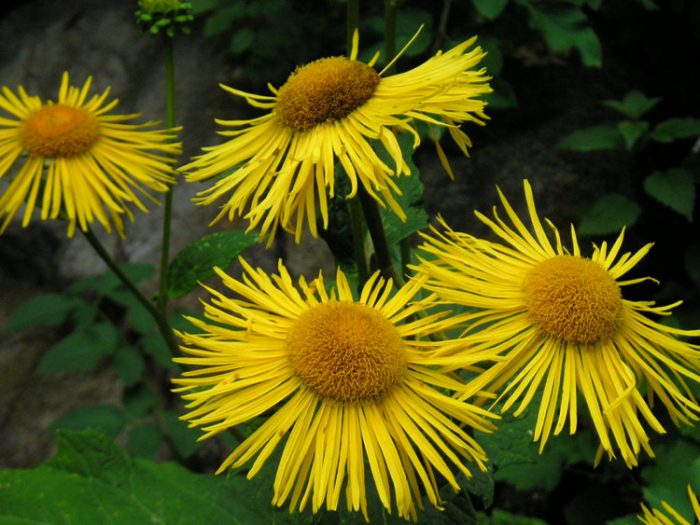
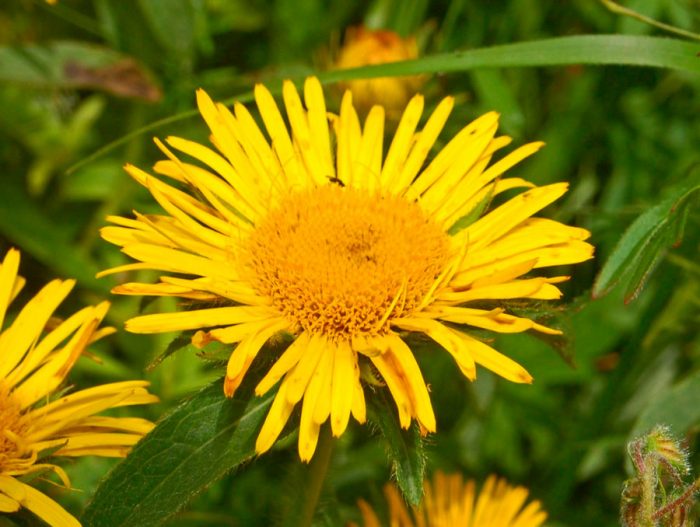
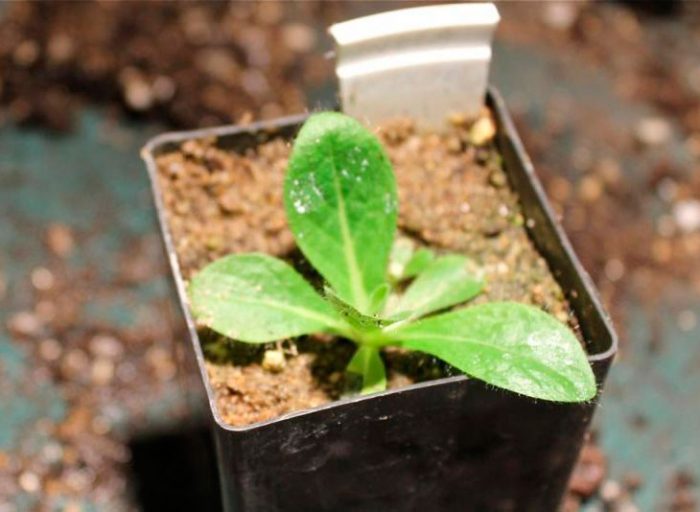
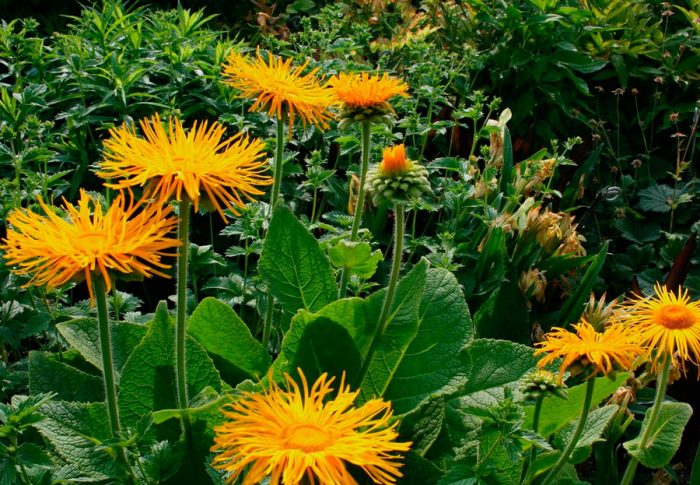
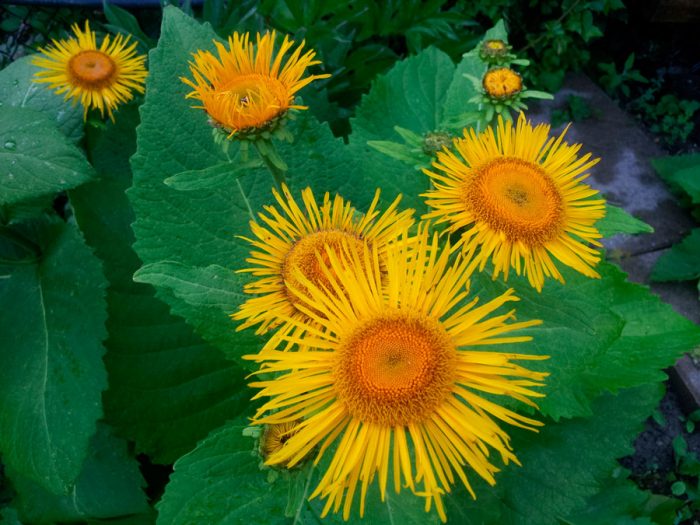

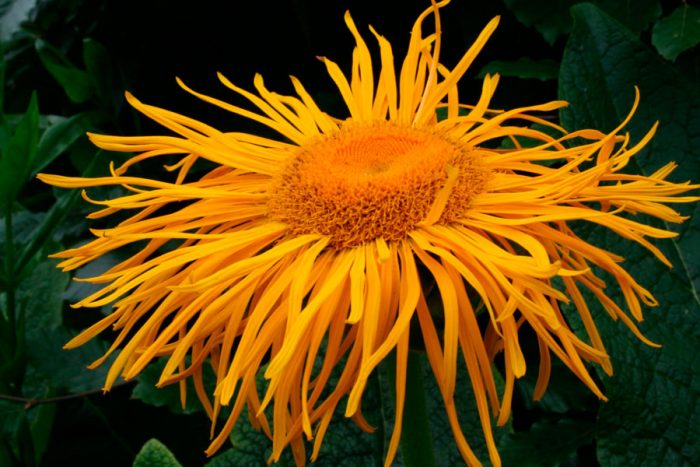
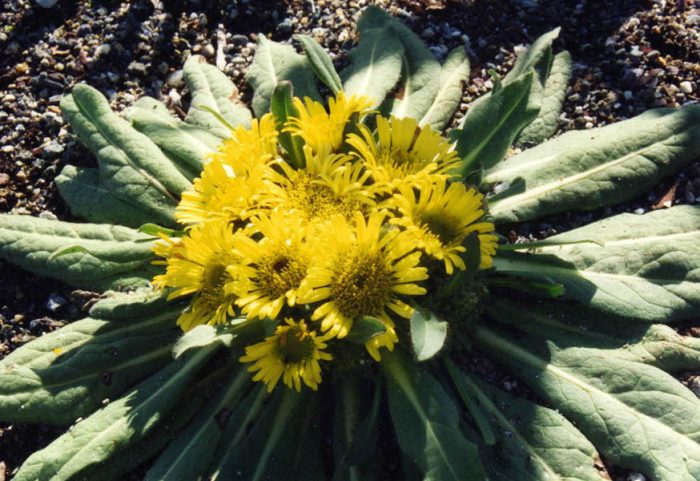
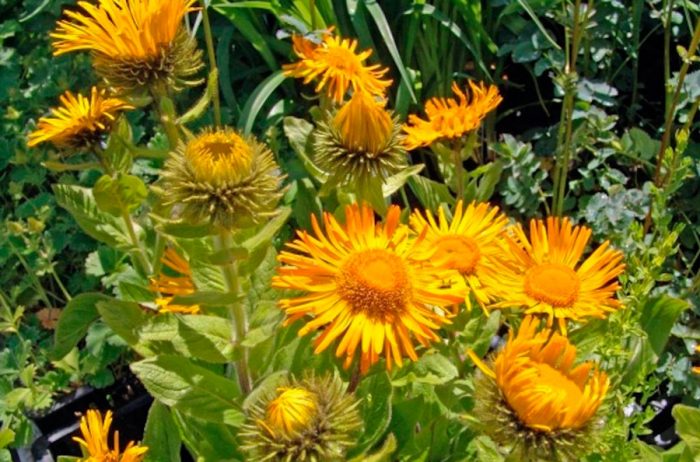

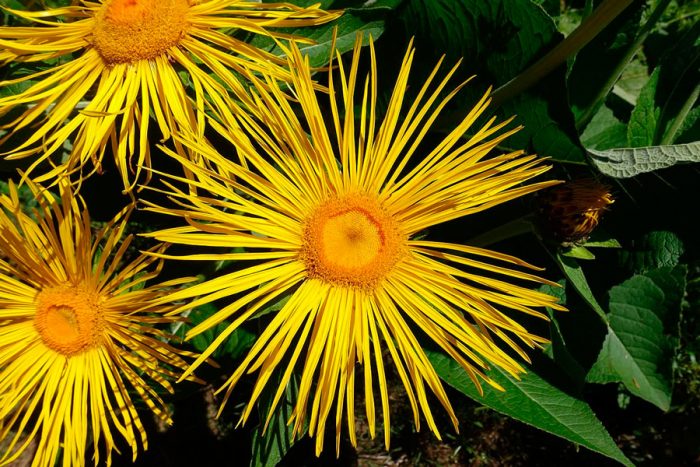
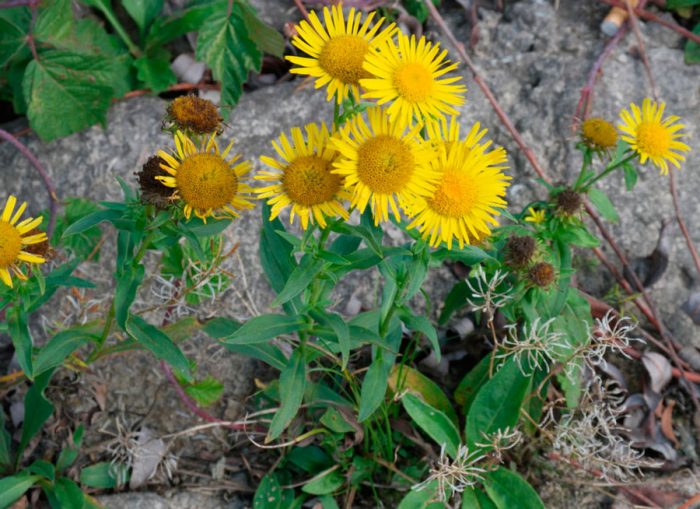
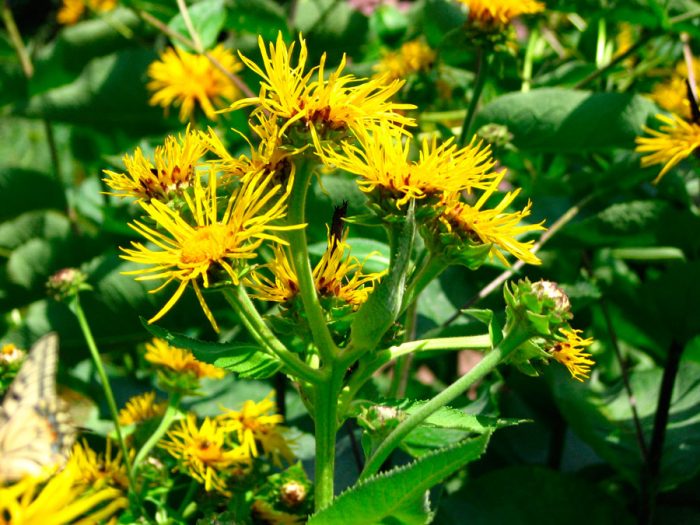
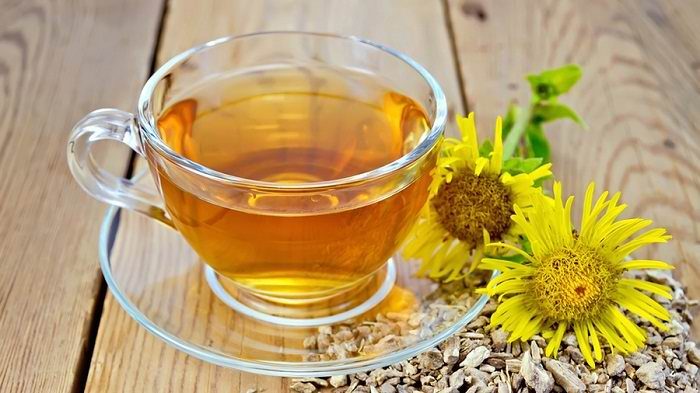

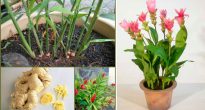

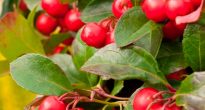




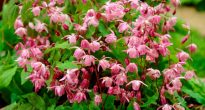


Thanks a lot for the article. Lots of useful and well-structured information.